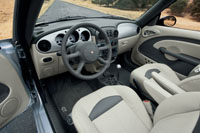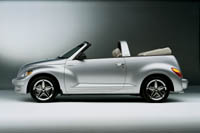|
I'm not sure
if Americans like retro-styled new cars as much as they used
to. But if you're a convertible buyer, don't let the looks of
the retro-styled, 2005 Chrysler PT Cruiser convertible stop
you from checking out this car. It's the lowest-priced drop-top
auto on the market with a starting manufacturer's suggested
retail price, including destination charge, of $19,995 at its
introduction.
 The PT convertible also comes with four usable seats that sit
up a bit from the floor, allowing passengers to enter and exit
more easily than they can in many other convertibles where riders
sit close to the floor. And the PT convertible's "sport bar"
- a metal structure behind the front seats that helps provide
a solid, rigid ride - adds a stylish touch when the fabric top
is down.
The PT convertible also comes with four usable seats that sit
up a bit from the floor, allowing passengers to enter and exit
more easily than they can in many other convertibles where riders
sit close to the floor. And the PT convertible's "sport bar"
- a metal structure behind the front seats that helps provide
a solid, rigid ride - adds a stylish touch when the fabric top
is down.
The next lowest-priced, four-seat convertible is the 2004
Volkswagen New Beetle Convertible, which starts at more than
$21,000, and the two-seat Mazda Miata roadster starting at over
$22,000. Granted, the PT Cruiser, which debuted as a four-door
hatchback with retro looks, has lost its luster. Sales of 107,759
in calendar 2003, for example, were off 25.5 percent from the
peak 144,717 sales in 2001.
But there's much to like in this drop-top PT, whose looks
belie the extensive engineering that was needed to create a
solid-riding, shake-resistant convertible. The PT convertible
"is not a coupe with a top chopped off," said Larry Lyons, vice
president of small vehicle product team engineering.
To make the convertible, officials said they changed the PT
hatchback from the windshield pillars and back. They added new
"smart glass" windows that automatically lower and rise back
up when the doors are opened in order to retain good sealing
against the fabric top. These windows first debuted years ago
on some of the luxury convertibles. Engineers took away two
of the PT hatchback's doors, leaving the convertible with two
long doors, instead. 
They strengthened the rear seat structure, re-tuned suspension
components and designed the novel sport bar that extends, wing-like,
above the rear seat area. Besides contributing to the car's
rigidity, this bar also serves to direct air over and beyond
the rear seat for less wind buffeting for passengers.
But the PT convertible does share the same engines and transmissions,
as well as the basic suspension setup - MacPherson struts in
front and twist axle beam with Watt's linkage in back - of the
PT hatchback. It has the same platform and overall size, too.
In fact, during the test drive, the PT convertible - with
an almost-bustled-at-the-back fabric top - didn't draw attention,
except from people driving PT hatchbacks. Other drivers paid
no mind.
The tester was a mid-range Touring Edition with optional 2.4-liter,
turbocharged, double overhead cam four cylinder. It produces
180 horses, up from the 150 of the base, non-turbo engine, and
210 lb.-ft. between 2,800 rpm and 4,500 rpm, up from the 165
at 4,000 rpm. There are two available manual transmissions,
for this model, but the tester was equipped with the four-speed
automatic transmission.
The engine worked well to power the convertible, which weighs
at least 150 pounds more than the PT hatchback. The response
from the engine wasn't instantaneous, but the lag was minimal
when pressing the accelerator and seeking to move aggressively. Note there also is a second, more powerful turbo, with a 220-horse,
high-output turbocharged, 2.4-liter four with 245 lb.-ft. of
torque between 2,400 rpm and 4,500 rpm. This is available in
the convertible GT model. The PT convertible is not offered
with a V6 or V8, as buyers would find in the Ford Mustang convertible.
Meantime, the New Beetle and Miata each offers two four-cylinder
engines, one turbo and one not.
Fuel economy in the test PT convertible was rated at a rather
ho-hum 20 miles a gallon in city driving and 25 mpg on the highway.
Regular unleaded being the recommended gasoline.
 Beyond the retro look and the two turbos, though, the most impressive
part of the PT convertible is the solid ride. I looked for the
characteristic convertible shudder as I traversed road bumps
and found precious little evidence of it. This is especially
true when the top is up on the vehicle. Just about all I saw
was a bit of shake at the rearview mirror when I went over bumpy
railroad crossings. When I hit sizable road bumps, it felt like
the whole car hit them solidly. There wasn't a sensation that
the bump jiggled through the entire vehicle structure. Beyond the retro look and the two turbos, though, the most impressive
part of the PT convertible is the solid ride. I looked for the
characteristic convertible shudder as I traversed road bumps
and found precious little evidence of it. This is especially
true when the top is up on the vehicle. Just about all I saw
was a bit of shake at the rearview mirror when I went over bumpy
railroad crossings. When I hit sizable road bumps, it felt like
the whole car hit them solidly. There wasn't a sensation that
the bump jiggled through the entire vehicle structure.
The front-drive test car rode on standard 16-inch wheels and
tires. There was some wind and road noise, but nothing that
prevented one from conversing with passengers, even with the
top down.
The three-layer fabric top, available in black or taupe, is
easy to put down. There's one manual chore inside: Grabbing
hold of a circular handle at the front of the roof and turning
it to release the two latches at the windshield. Then, it's
merely a push of a button, and the "smart glass" windows drop
a bit - or all the way, depending on which detent you've activated
- and the fabric top, with glass rear window, folds down and
stows at the back. Note the boot, or cover, for the top must
be hauled out of the trunk and installed manually. There are
two snaps to hold it in place. But even with the boot on, the
top sort of sits up at the back of the vehicle and doesn't allow
a clear rear view. The mechanical process reverses when you
put the top up.
Seats in this convertible are upright and supportive and a
welcome surprise because they don't sit close to the floor.
Rather, they're up a bit, with the second-row of seats up even
higher than the front ones for a theatre seating effect. However, the rear seats sit on a tall ledge that rises from
the floor and the plastic attachments for the seats were always
the first things I saw when I climbed into the back. Still,
all riders in the PT convertible have a sense that even if it's
difficult for them to see around vans and trucks in front of
the vehicle, they're not scraping along the pavement, either.
But note that when the top is on, the large rear window pillar
blocks the driver's view out to the back and side. And the sport
bar as well as sizable front head restraints curtail the views
for back-seat riders. Looking for the window buttons? They're in the center stack
of the dashboard, not on the doors.
I liked that the retro styling is retained inside the PT convertible
as parts of the dashboard sport plastic pieces that coordinate
with the exterior paint. And the PT is one small car that doesn't come with a small-car,
"beep-beep" horn. Its horn sounds more like that of a larger
auto.
There is a lot of weather-stripping on the doors and windows
of this car; on the test vehicle, it looked as if it had been
installed in a sort of ham-handed manner.
 Rear-seat headroom of 36.4 inches is less than the 37.2 inches
in the New Beetle convertible. The New Beetle has more front
headroom, too, and each time I was in the PT convertible driver's
seat I noticed how low the fabric roof came down to join with
the top of the windshield. Quite frankly, with the driver's
seat adjusted up a ways for me to drive comfortably, I felt
as if the roof was located at my forehead. Note the PT convertible's
front and rear headroom is also less than that of the PT hatchback.
At 60.6 inches tall, the convertible is shorter than the 63-inch-tall
hatchback. Rear-seat headroom of 36.4 inches is less than the 37.2 inches
in the New Beetle convertible. The New Beetle has more front
headroom, too, and each time I was in the PT convertible driver's
seat I noticed how low the fabric roof came down to join with
the top of the windshield. Quite frankly, with the driver's
seat adjusted up a ways for me to drive comfortably, I felt
as if the roof was located at my forehead. Note the PT convertible's
front and rear headroom is also less than that of the PT hatchback.
At 60.6 inches tall, the convertible is shorter than the 63-inch-tall
hatchback.
For More Information Click: Chrysler
PT Cruiser Convertible For
the Chrysler 2005 Model Guide : Click
Here
|